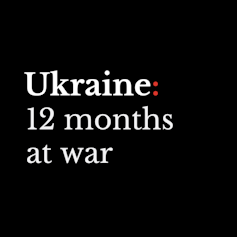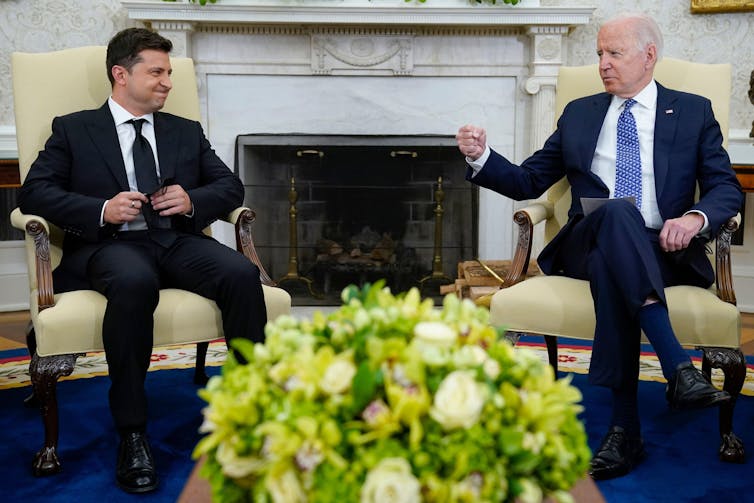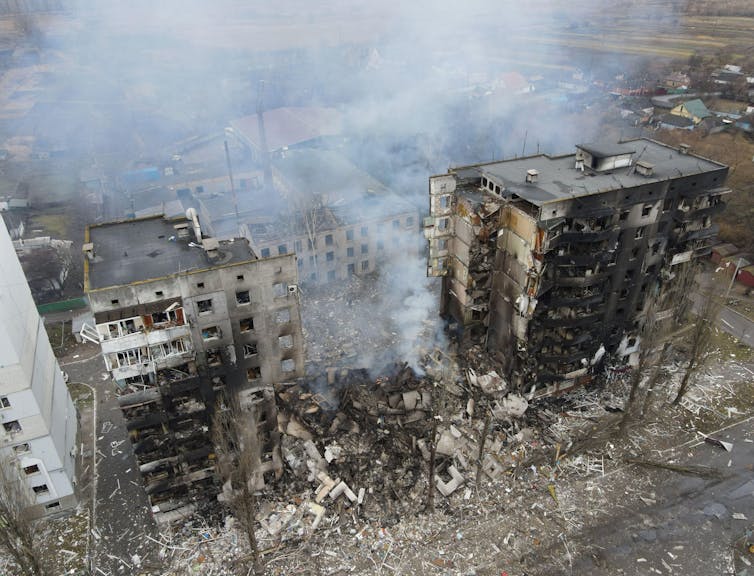It would be wrong to say that nobody saw this war coming. Vladimir Putin’s troops had been massing on the Ukraine border in Russia and its ally Belarus for some months. And, despite his assurances to the contrary, the president’s bellicose rhetoric and his insistence that Ukraine was an inalienable part of the Russian nation, were pretty clear signposts that an invasion could be imminent. Take, for example, the weird, rambling speech on February 21 2022 in which he referred to his neighbour as “a colony with a puppet regime” which has no historical right to exist.
And yet to wake on the morning of February 24 to images of Russian tanks and armoured vehicles making for the Ukraine capital Kyiv, was still a huge shock. Of course, even then, Putin insisted this was was not an invasion, but a “special military operation” to root out the “Nazi gang” that the west had installed in Ukraine as part of its dastardly plan to encircle Russia.
The operation would take a matter of days, we were told. And yet, 12 months on, the fighting continues and Ukrainians and Russians continue to die in their thousands.
Over the year, we’ve been very fortunate to have the insights of Frank Ledwidge, an expert in military strategy at the University of Portsmouth, whose regular analysis of developments on the battlefield have proved to be remarkably sharp and prescient. In his summary of the year on the battlefield he points to three major factors that have contributed to Russia’s disastrous campaign: the staunch ferocity of Ukraine’s defence, Russia’s woeful, corrupt and muddleheaded military leadership, and the ongoing support of Kyiv’s western allies who have trained and equipped Ukraine’s military.

Since Vladimir Putin sent his war machine into Ukraine on February 24 2022, The Conversation has called upon some of the leading experts in international security, geopolitics and military tactics to help our readers understand the big issues. You can also subscribe to our weekly recap of expert analysis of the conflict in Ukraine.
There’s no doubt that the materiel supplied by Kyiv’s friends in Europe and North America continue to make a significant contribution to Ukraine’s war effort. Ledwidge expects a fresh Ukraine offensive in the coming weeks, which, as he writes, could “define the shape of the rest of the war, determining whether victory will come this year, or whether this will be a long and even more grinding conflict”.
Read more: Ukraine war: why Russia has had such a disastrous 12 months – and what to expect next
It does, however, seem appropriate to add one other factor to the list of reasons why Ukraine has performed better than many expected: the quality of its leadership. Or rather, its leader, Volodymyr Zelensky, who has come to embody Ukrainian spirit and heroism.
Heroes are particularly important in times of conflict or crisis, as Jenny Mathers from Aberystwyth University has found in her research. Here, she writes for us about how Zelensky has become an unlikely hero, both in his own country and worldwide, partly due to his determination not to leave Ukraine during the war, despite the risk to his own life.
Read more: Ukraine war 12 months on: how Volodymyr Zelensky became the nation's unlikely hero
And, as in so many narratives, a hero demands a villain – in this case, the Russian president. Just the other day, Putin delivered his “state of the nation” address, in which he doubled down on his contention that this isn’t a war against Ukraine, but a confrontation between Russia and the west.

This is consistent with the Russian president’s narrative since before he sent his troops into Ukraine. Putin, writes Precious Chatterje-Doody from the Open University, understands the power of repeated lies and misinformation. And it seems to have worked for the Russian people, many of whom still wholeheartedly support the invasion, despite the massive – and growing – body count and the prospect of more conscription in coming months. Of course, she writes, it helps when you have a tame media under your control.
Read more: Ukraine war: how have Vladimir Putin’s narratives survived a year of reality checks?
One of the most obvious bits of Kremlin misinformation is that this is simply a limited military operation by Russian troops. But in fact – and this is something that has largely gone unremarked over the year, Russia has still not officially declared war on Ukraine. Why this matters, as Robert M. Dover from the University of Hull details, is that a full declaration of war would allow Putin to lever a greater level of conscription, diverting even more resources towards the military campaign. It may also be a sign that Russia doesn’t want to widen the conflict into an international war.
The key thing that many will have taken from Putin’s speech is that he has pulled Russia out of the New Start nuclear arms limitation treaty with the US. Putin’s regular and inflammatory rhetoric about the possible use of his nuclear arsenal (Russia would, of course, not strike first, he said) is an enormous cause for concern.
As Dan Plesch, an international security expert at SOAS University of London, points out, it is largely due to the now-defunct INF treaty, that Russia has not had access to ground-to-ground ballistic and cruise missiles with ranges from 500km to 5,500km. The damage these weapons would have been able to do, if they had been available, doesn’t bear thinking about.
Meanwhile western confidence in Ukraine’s leadership and its commitment to the country’s security was dramatically illustrated this week when US president Joe Biden paid a surprise visit to Kyiv. Walking the streets alongside Zelensky and reaffirming the west’s commitment to back Ukraine whatever it takes, he said: “Kyiv stands and Ukraine stands. Democracy stands. The Americans stand with you, and the world stands with you.”

The University of Birmingham’s international security expert, Stefan Wolff – who has been a regular contributor since the beginning of the war – believes: “Biden’s visit underscores that the west has every confidence that the Russian president will not win this war and is finally coming round to the idea of providing Ukraine with what it needs to defeat Russia.”
On the battlefield
It’s clear that to a large degree – and notwithstanding the bravery and discipline of Ukraine’s defenders – western military hardware and training have had a lot to do with this success on the field of battle.
Laura Jones, a doctoral researcher in international relations at Tufts University in the US, runs us through the different classes of weapons that have been made available to Ukraine over the course of the conflict. She contrasts Ukraine’s success in integrating this materiel into its military strategy with the at-times hapless performance of Russia’s armed forces, which have been hampered by poor leadership and low morale since the early days of the invasion.
Ukraine is still begging the west to supply it with its most sophisticated and up-to-date aircraft, which could help it take control of the skies. Matthew Powell, an expert in air power at the University of Portsmouth, explains how the use of aircraft in warfare has developed since Italian pilots began to drop bombs from their cockpits during a campaign in Libya back in 1911.

If supplied to Ukraine, modern multi-role aircraft could offer a significant advantage. But, Powell cautions, even if (as is looking increasingly likely) western allies agree to supply Kyiv with their most modern aircraft, it could take months, even years, to train the pilots and incorporate the planes into Ukraine’s overall military strategy.
Read more: Ukraine war: history shows why Zelensky's mission to secure modern jet fighters is so crucial
An often-overlooked theatre of war – and yet in some ways the most important of all – is the ocean. Taking control of the sea would have allowed Russia to effectively blockade Ukraine and give Moscow the option of mounting an amphibious assault on the key port city of Odesa. But instead, Ukraine managed to sink the flagship of Russia’s Black Sea fleet, the Moskva.
Maritime morale was further boosted when Ukrainian forces retook Snake Island, a small but strategically vital outpost in the Black Sea (about 70 nautical miles south of Odesa) that had been taken by Russian forces in the opening days of the conflict. This became a symbol of Ukrainian resistance. The picture of a defender giving the finger to a Russian warship was featured on a postage stamp.
Drone strikes against the Black Sea fleet in their harbour at Sevastopol followed. Basil Germond, a maritime expert at Lancaster University, has been following the war at sea.
Read more: Ukraine: Russia's inability to dominate the sea has changed the course of the war
Away from the frontline
As well as supplying Kyiv with weapons, western support has included what where generally considered to be crippling sanctions directed against both the Russian economy and Putin’s elite circle of oligarchs and political heavyweights. The idea, writes Peter Rutland, a professor of government at Wesleyan University in the US, was to starve Putin’s military-industrial complex of funds while also turning his key supporters against him.
But, as Rutland notes here, this has not been as successful as had been hoped in the west. While many countries faithfully observed the sanctions, accepting the pain of weaning their own economies off cheap Russian oil and gas, Moscow still has plenty of customers and enjoyed a boom year for energy revenues in 2022. And, of course, Russia has learned to live with and work around sanctions for years.
Read more: How Putin has shrugged off unprecedented economic sanctions over Russia's war in Ukraine – for now
It’s all too often overlooked that sanctions also affect the countries imposing them and many countries that support Ukraine are still suffering the effects of rocketing food and energy prices. On top of that, Ukraine’s allies are coping with millions of refugees who have fled their homes to seek safety across Europe.
Sara Jones and Natalia Kogut have conducted a series of interviews with Ukrainians who ended up in the UK. They found that while most Ukrainian refugees are endlessly grateful to their hosts’ generosity, many have faced obstacles in finding suitable homes and jobs, making their enforced exile all that much harder.
Read more: Ukraine war: a year on, here’s what life has been like for refugees in the UK
Another inevitable result of war is the trauma faced by those who have been forced to fight for their lives, or who have seen their homes destroyed, their loved ones killed or badly injured, or who have themselves faced violence, often – in the case of women – sexual violence or abuse. Recent surveys suggest that more than 25% of Ukrainians suffer from post-traumatic stress disorder (PTSD). This, according to Matt Fossey of Anglia Ruskin University and his fellow researchers, is putting terrible strain on a health system that was already inadequate, underfunded and outdated.
Read more: Ukraine war: conflict-related PTSD is putting strain on an already underfunded mental health system
How did we get here (and what might 2023 bring?)
Arguments will continue to rage – particularly given Putin’s insistence that this war is a result of western provocation and Nato’s relentless eastwards expansion – is how Russia and the west became so polarised so soon after the end of the cold war.
In the heady last years of the 1980s and early 1990s, when Mikhail Gorbachev (a leader Margaret Thatcher said she could do business with, you’ll remember) the idea of a dangerous cold war-style confrontation seemed so far away. But, as Gilbert Achcar – an expert in international relations at SOAS, University of London – writes, we should have seen this coming for some years. And both sides ought to bear some blame for the estrangement that has led to this conflict in Ukraine.
Achcar warns that this “new cold war” must be brought to an end, and soon. The possibilities otherwise for a for a catastrophic confrontation are too dreadful to contemplate.
Read more: Ukraine: this new cold war must end before the world faces Armageddon
"conflict" - Google News
February 24, 2023 at 01:10AM
https://ift.tt/nArxzdp
Ukraine recap: how the conflict stands after 12 months of bitter fighting - The Conversation
"conflict" - Google News
https://ift.tt/9t7uMXH
https://ift.tt/rtiU9Kf
Bagikan Berita Ini














0 Response to "Ukraine recap: how the conflict stands after 12 months of bitter fighting - The Conversation"
Post a Comment